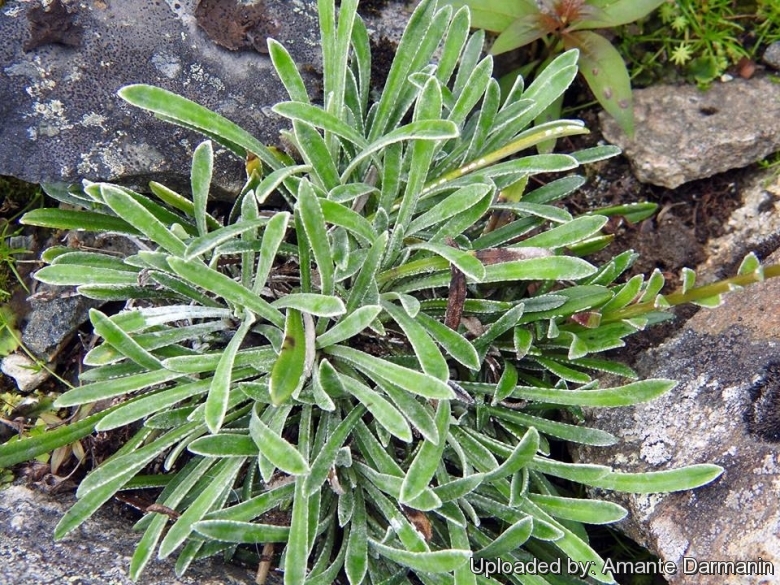Accepted Scientific Name: Saxifraga callosa Sm.
Cycl. [A. Rees], (London ed.) 31: [n. 2]. 1815 [21 Sep 1815] Rees

Evaiezoa callosa (Saxifraga callosa) Photo by: Amante Darmanin
Tromso botanical garden, Norway.10/7/17
Origin and Habitat: South and Western Europe and South-east Europe (especially common on the Iberian Peninsula (Spain) and sometimes even in the Central Massif (France) and in the East of Alpes-Maritimes, region of Tende, Apuan Alps, north and center of the Apennines to southern Italy, Sardinia and Sicily. It is rare or missing in the Balkan.
Altitude range: 200-2000(-2500) metres above sea level.
Habitat and ecology: Saxifraga callosaSN|34597]]SN|34597]] is a typical colonizer of rocky more or less vertical limestone cliffs and rocks.
On the Apuan Alps it is the largest species among the many saxifrages present. In the blooming period it adorns entire rock walls providing spectacular views. The diffusion of the species occurs exclusively through seeds.
Synonyms:
See all synonyms of Saxifraga callosa
back
Accepted name in llifle Database:Saxifraga callosa Sm.Cycl. [A. Rees], (London ed.) 31: [n. 2]. 1815 [21 Sep 1815]Synonymy: 12
Accepted name in llifle Database:Saxifraga callosa subs. catalaunica (Boiss. & Reut.) D.A.WebbFeddes Repert. Spec. Nov. Regni Veg. 68: 208 1963.Synonymy: 2
back
Common Names include:
ENGLISH: Encrusted saxifrage, Silver Saxifrage
FRENCH (Français): Saxifrage
ITALIAN (Italiano): Sassifraga meridionale
SPANISH (Español): Corona de reina
Description: Saxifraga callosaSN|34597]]SN|34597]] is an herbaceous, evergreen, tightly rosetted plant 20-60 cm high that forms spreading mats of long, linear, stiff, silvery encrusted leaves. In early summer, it produces upright, then arching panicles of star-shaped, red-spotted white flowers. The rosettes die after flowering.
Derivation of specific name: With thick skin, with calluses.
Stems: Woody with flowering branches, erect or ascending, glabrous and usually reddish.
Leaves: Basal leaves in rosettes, leathery, (2-)2.5-4(-8) cm long, elongate to narrowly linear or slightly spatulate (stretching and recurved at the apex) varying considerably in both length and width according to locality of occurrence. The leaves are characteristically dotted on the rim by white calcium carbonate secretions that imitate a dentition. The leaves on the flowering stems becomes gradually smaller and reduced to linear brats.
Inflorescence: Weakly hairy, with numerous flowers (even hundreds) often unilaterally arranged
Flowers:* Calyxes, glabrous, with 5 oval-obtuse lobes and corolla formed by 5 spotted white petals, usually minutely dotted with purple.
Bloming season (Northern hemsphere: May-June (July)
Fruit (capsule): Obovoid with numerous fusiform seeds.
Taxonomy: Two subspecies have been described, subsp. callosa from the Alps and Apennines, Italy, with leaves 2.5-9cm long and 2.5-6mm wide and subsp. catalaunica from north-eastern, Spain and southern France, with leaves 1.5-3 cm long and 4-6 mm wide. Within this geographical range, intermediate forms between these extremes have been collected and given varietal names. The existence of high morphological variation within different subspecies and varieties indicates that phenotypic characters are useful but not sufficient taxonomic tools. Indeed, available morphological data already suggested that S. callosa subentity lantoscana may be an outcross between S. callosa and S. cochlearis. There are also several named cultivars which differ in the height of the flower stem and the size of the silvery rosettes.
Bibliography: Major references and further lectures
1) Pignatti S., "Flora d'Italia", 3 voll. Edagricole, Bologna 1982
2) Conti F., Abbate G. Alessandrini A. Blasi G., "An Annotated Checklist of the Italian Vascular Flora", Roma, Palombi editori, 2005
3) Ansaldi M., Medda E., Plastino S., "I fiori delle Apuane", Mauro Baroni & c. s.a.s., Viareggio 1994
4) Fferrarini E., Marchetti D., "Prodromo alla Flora della Regione Apuana", Accademia Lunigianese di Scienze Giovanni Capellini, La Spezia, 1994
5) Giuliano Salvai - "Saxifraga callosa Sm. - Sassifraga meridionale". In Acta Plantarum, Forum. Disponibile on line (data di consultazione: ): http://www.floraitaliae.actaplantarum.org/viewtopic.php?f=95&t=2934
6) Andre Gonard, "Saxifragacees: Flore pratique adaptee a la France Utilisation des especes horticoles et ornementales", Universite de Saint-Etienne, 2006
7) James Armitage, "A Portable Latin for Gardeners: More Than 1,500 Essential Plant Names and the Secrets They Contain", University of Chicago Press, 22 February 2017
8) Christopher Brickell, RHS Encyclopedia of Plants and Flowers, Dorling Kindersley Ltd, 01 September 2010
9) Saxifraga callosa in: Plant Encyclopaedia, The Alpine Garden Society. Web: http://encyclopaedia.alpinegardensociety.net/plants/Saxifraga/callosa
10) Grassi, F., Labra, M., Minuto, L., Casazza, G. and Sala, F. (2006), "Natural Hybridization in Saxifraga callosa Sm.". Plant Biology, 8: 243?252. doi:10.1055/s-2005-873047
11) Webb, D.A. & Gornall, R.J. (1989), "Saxifrages of Europe", Christopher Helm, London.
12) Minuto, L., Casazza, Labra, M., Sala, F. and Grassi, F., "HAPLOTYPE RICHNESS IN REFUGIAL AREA OF MARITIME ALPS: PHYLOGEOGRAPHICAL STRUCTURE OF SAXIFRAGA CALLOSA AND RELATIOSHIPS WITH RELATED TAXA", Boll. Mus. Ist. Biol. Univ. Genova, 72: 124-129, 2010











